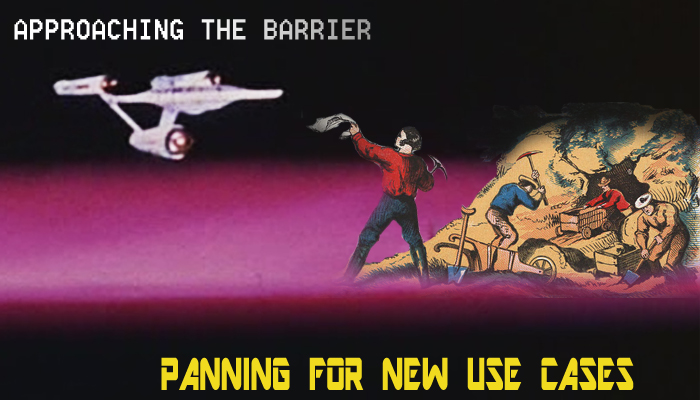“New use cases and their subsequent solutions are like a feedback loop that creates a gravity well of chaotic innovation.”
Part 7 – Panning for new Use Cases
This is the last of a seven-part series considering the ongoing transformation of information technology as a result of the six independent yet highly synergistic evolutionary threads, shown in the diagram below. We’ve gone full circle, talking about the theme of composability in hardware and software, the role of cloud and software-defined networking, the impact of the triumvirate of containers, the API economy, and microservices. Unlike these five threads, which are focused on the “How?” of the technology itself, this final installment focuses on the “Why?”

An interesting point about all of these technology threads: they’ve been in motion, plotting their respective trajectories for many decades. The ideas that are just now finding practical, wide-spread application were conceived before the many of the programmers writing the production code were born. One of the best examples is mobile devices that have uninterrupted Internet connectivity. Another is the fully distributed operating system, in which the location of computer resources and data become almost irrelevant to the end user. Academic papers treating these topics can be found at least as early as the 1980’s, with Tanenbaum and Renesse’s ACM Computing Surveys paper on distributed operating systems appearing in 1985 as a good summary. Once these capabilities move from science fiction to science fact, new fields of innovation are unlocked, and use cases heretofore not even considered begin to come into focus.
Not only have new use cases drawn the threads of evolving technology into a tapestry of increasing value from IT, they also create demand for new innovations by highlighting gaps in the current landscape. Just a little additional creativity and extra work can fill in these cracks to deliver truly mature solutions to problems that were never even known to be problems, because thinking of them as problems was too far outside our normal way of life. At the heart of the disruption are the abilities to coordinate resources, influence the actions of individuals, and transfer funds friction-free in microseconds – all on a massively global scale. Many aspects of life on Earth have been curtailed by assumptions that such synchronization and fiscal fluidity are more than not possible, but never would be possible. The cracks in those assumptions are now beginning to weaken the status quo.
The “sharing economy” is a good example of a class of stressor use cases. Business models adopted by such companies as Uber, Lyft, HomeAway and Airbnb approach problems in ways that would have been unthinkable 20 years ago: by crowd-sourcing resources and intelligently brokering them in a matter of seconds. Only now, with the ubiquitous Internet, distributed cloud, and mobile connected devices, can such a scheme be implemented on the massive scale required to make it workable. But in addition to solving previously unstated problems, these solutions also challenge the very assumptions upon which businesses models and legal systems have been based for centuries. Case in point: taxi companies are the only entities capable of creating privately run public transit, so regulating taxi companies solves the problem of regulating privately run public transit. A similar case exists for hotels. Not only does the sharing economy and the ensuing IT transformation break these long-standing assumptions, they also create new opportunities for innovating on top of them, finding new ways to create and distribute wealth, and achieve better self-governance.
New use cases and their subsequent solutions are like a feedback loop that creates a gravity well of chaotic innovation. It pulls technology forward, and the center of that gravity well gets larger with each new contribution. That pull accelerates things, like innovation, and destroys things, like outmoded models and invalid assumptions. Such a mix is ripe with opportunity! It’s no wonder that the modern template for success is the tech startup, the new California Gold Rush to find the next killer app and new use case, with barriers to entry so low that over half a million new ventures are launched each year. There is no doubt that such a dynamic, evolving environment of collaboration combined with creative thought from those who have not be trained in the old ways, will produce new solutions for a host of other problems humanity has, until now, simply assumed could never be otherwise.
The question of whether the human organism or its social and political constructs can accommodate the pace of change we are foisting upon them at such a global scale is still unanswered, as is the uncertainty surrounding the safety of the massively complex and interconnected systems we are fashioning. It doesn’t matter, though, because the laws of gravity must be obeyed: the opportunity is too big, its draw inexorable, and the rewards potentially too great. The tracks have been laid over many decades crossing a continent of human technical evolution, transporting anyone who has a reasonable credit limit and the adventuresome spirit of entrepreneurship to their own Sutter’s Mill, a keyboard in their backpack with which to pan for the new gold.



